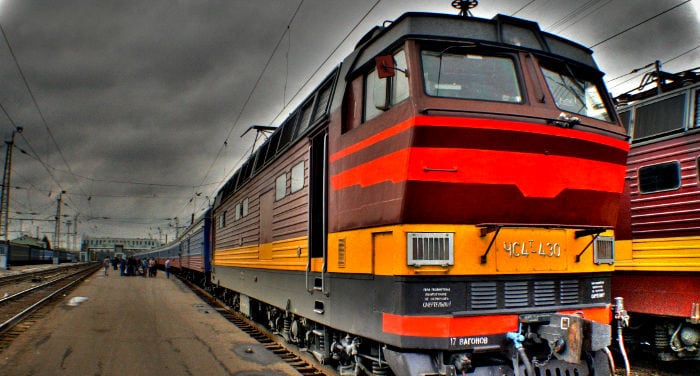
Before getting started
The purpose of this article is to share my experience and offer all of the practical information necessary for you to enjoy an unforgettable trip on the Trans-Siberian railway.
If you’re looking for specific information on Trans-Siberian tours,click here to read our guide. You can also fill out this form to get a free budget.
If what you’re interested in is knowing how much Trans-Siberian train tickets cost, click here, select the day, departing city and destination and you will get the prices of tickets (use the city names in English).
Last of all, if you’re looking for a story about the experience of traveling on the Trans-Siberian Railway, I suggest that you read this story.
Transsiberian Train Trip Guide – Index
- Trans-Siberian myths and incorrect beliefs.
- Why should you take the Trans-Siberian Express?
- Where to buy the tickets for the Trans-Siberian Railway
- Railcar and train classes
- To get a tour or to travel by myself?
- Which route should you choose?
- Where to stay? Our suggestions for hotels in Moscow, Irkutz, Ulan Bator and Beijing
- Russian, Mongolian and Chinese Visa requirements
- Things you should bring with you
- Essential information and tips
Trans-Siberian myths and wrong beliefs
The Trans-Siberian is a single train
What is commonly called the Trans-Siberian is in fact a railway network used by many different trains. For instance, along the route between Moscow and Beijing, there are at least two rail lines: the Trans-Mongolian (the most popular) and the Trans-Manchurian.
The first one is the line that connects Moscow to Ulan Ude (Russia) and then reaches Beijing by crossing Mongolia (the trip lasts approximately five and a half days if you never get off the train).
Conversely, the Trans-Manchurian goes along the Moscow-Vladivostok line but before reaching Vladivostok, is diverted to the Chinese border, crosses Manchuria and ends in Beijing (this route takes more than six days).
Therefore, if we want to be precise, the Trans-Siberian is the Moscow-Vladivostok line.
The Trans-Siberian is a drop-off ticket
Although for some people it may seem obvious, there are still many people that believe that the Trans-Siberian is something similar to the InterRail in Europe (that is, you buy a ticket and you get on and off the train as many times as you like).
The reality is that the Trans-Siberian railway is only a rail line, so you have to buy separate tickets for each journey you want to do.
The Trans-Siberian is expensive
The Trans-Siberian probably offers the most economic train tickets per kilometer in the world. The price of the journey varies greatly depending on the stops you make (the more you stop, the more you pay), the train class (fast trains are more expensive) and the railcar class that you choose.
For example, the Moscow-Beijing route in second class (that is, one of the most expensive trains) with a stop in Irkutsk is around 700 USD. You can click here to find out how much your train tickets are going to cost. You just need to fill out the form to get the ticket prices.
The Trans-Siberian is a luxury train
I don’t know what image you have of the Trans-Siberian, but before taking it, I always assumed that the Trans-Siberian was a luxury train. I guess it’s because of the movies! The truth is that the Trans-Siberian is far from being a luxury train; most trains are quite old and have lost all the possible glamor they may have once had. However, there are top class trains as the Golden Eagle. This trains are not regular (they depart at most once a week in high season) and they are aimed to tourists with high purchasing power.
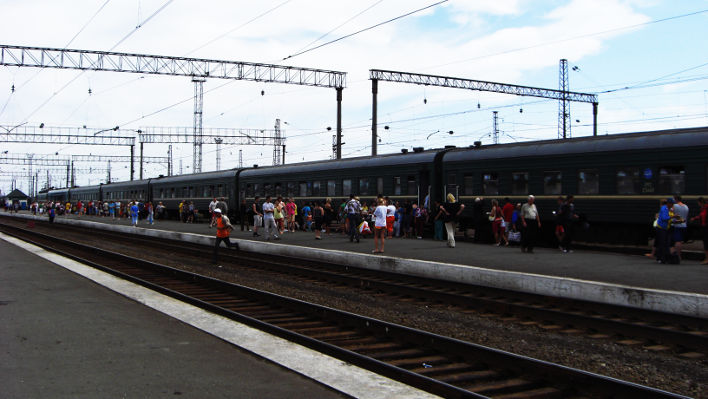
One of the daily long stops: a perfect time to purchase some food!
Why should I travel with the Trans-Siberian?
When I tell people that I took the Trans-Siberian, they first claim they envy me, but then add:
“I couldn’t spend all that time locked in a train!”
When I think about my trip, one of the priceless memories I have is the three days I spent “locked” on the train from Moscow to Irkutz.
In my opinion, the train journey is a unique experience for the following reasons:
Landscapes: The Trans-Siberian is a sight to behold. You have to experience it for yourself!
People: Despite the (bad) reputation that Russian people may have and the language barrier (most people only speak Russian), something similar to what you can experience in China happens: many Russian people have never had the opportunity to meet foreigners. Therefore, they are quite curious and you will have plenty of opportunities to chat, share some drinks or just play cards with locals. It’s quite an experience!
Time zones: The Trans-Siberian crosses eight time zones. It may seem silly but going across so many time zones by land was pretty interesting in itself.
Where to buy tickets for the Trans-Siberian
Online
Trans-Siberian tickets can be purchased online on the Russian Railway’s official website. However, there are two problems: you won’t be able to purchase international tickets (for instance from Irkutz to Ulan Bator) or to purchase tickets more than 45 days in advance.
In order to avoid all these problems, you can use one of the many online agencies that will purchase any kind of tickets for you more than 45 days in advance. However, most of the agencies charge you abusive commissions and don’t offer all wagon classes and train types (only the most expensive).
I suggest that you purchase your tickets with Russian Train, as in my experience, they are by far one of the cheapest agencies, they can get you good discounts if you book in advance, they offer excellent service and can help you purchase any ticket you need all along the Trans-Siberian route (including international trains).
After booking your train tickets, you’ll receive an email with your electronic ticket (if this format is available) or an electronic ticket receipt that you must exchange for the paper ticket at the train station (most international trains don’t have electronic tickets).
Click here for more information on how and where to buy train tickets online
At train stations
Personally I don’t recommend it. Even though this used to be a very common way for people who don’t like to plan their trip in advance, there are couple of problems with it:
- Currently, buying train tickets online is very common, and it’s very likely that you won’t find tickets available.
- For many routes, you will get a discount if you book more than 15 days in advance.
- At ticket offices, it’s very rare to find someone who speaks English, so if you don’t speak Russian, this will be a bit difficult.
Through a travel agency
If you are traveling on a budget, you should avoid this option, as the prices offered by travel agencies are much more expensive and usually you can’t get the cheapest tickets (normally agencies only offer fast train tickets in first or second class). However, if you decide to get a full tour package with a reliable travel agency, the agency will get a good deal for you.
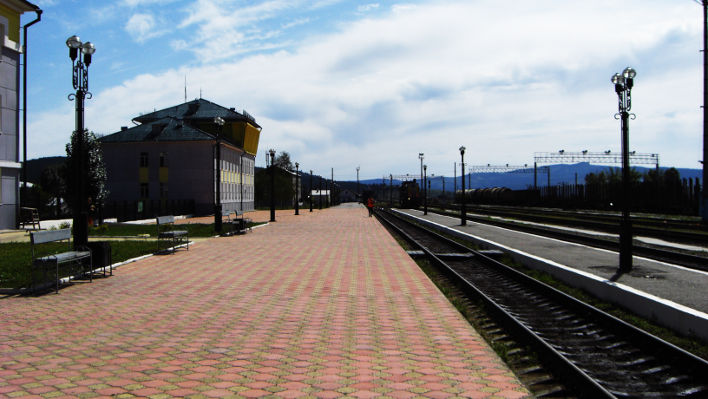 Crossing the Russian-Mongolian border
Crossing the Russian-Mongolian border
Railcar and train classes
Russian railcar classes
- Platzkart (P, third class, плацкарт): It’s by far the cheapest way to travel and probably the most fun, if you don’t mind socializing a bit with locals. The railcar doesn’t have any compartments and beds are both perpendicular and parallel to the corridor.
- Kupe (K, second class, купе): The railcar is divided into compartments of four beds each. It’s your best bet if you want to have a good rest at night without having to pay too much.
- Spalny Vagon (SV, first class, cпальный вагон): The railcar is divided into compartments with two beds each. It’s the most comfortable way to travel. However, the tickets are way more expensive than the second class tickets and you’ll miss out on one of the Trans-Siberian’s main attractions, learning about Russian language and culture by interacting with locals.
Russian train classes
- Top-class trains (firmenny, фирменный): the fastest and most comfortable trains (they only offer first and second class). Their prices are higher than those of airline tickets and are usually used by tourists because for most Russian people, the price is unacceptable. Identifying these trains is fairly easy as they have their own names. The most famous is the No. 1/2 “Rossiya,” which runs from Moscow to Vladivostok.
- Fast trains (skory, скорый): These trains only stop in major cities and are the most often used for long-distance trips. They are identified by the numbers from 1 to 170. This class also includes the Moscow-Beijing and Moscow-Ulan Bator international trains.
- Passengers trains (passazhirsky, пассажирский): These are the slowest and cheapest trains. They aren’t too convenient for long distances routes (from Moscow to Irkutz it will take five days instead of three days) unless you really need to save money. They can be recognized by their number, which is always over 170.
Chinese trains
You can find all the information you need on Chinese trains in a previous article called Travel by train in China.
Mongolian trains
In Mongolia, the main railway line crosses the country from north to south. It goes through the capital, Ulan Bator, and connects the Russian and Chinese borders. Although there is also a line that goes to the east (only part of the line carries passengers), in my experience, the trains that reach Ulan Bator are either Russian (on the north side) or Chinese (on the south side). So, I don’t have much to add.
To get a tour or to travel by myself?
Organizing a Trans-Siberian trip is time consuming and, if you make some mistakes, can be a bit expensive. In my opinion, if you aren’t an experienced traveler, you should consider getting a tour because Russia, Mongolia and China aren’t the easiest countries to travel around, mainly because most people are unable to speak English. A good agency should help you arrange your trip, stay away from problems and at the same time, allow you a certain degree of freedom.
Conversely, if you are an experienced traveler with a limited budget and you don’t care about spending the necessary time to organize a cheap trip, then traveling by your own will be your best option.
If you need more information on this topic, you can click here to read our guide on Trans-Siberian tours, where we discuss travel agencies, popular routes and tour prices.
Which route should you choose?
This is the big question, and it depends on many factors like how much time you have, what your interests are (nature, cities, culture …), where to start (Moscow, St. Petersburg, your home). If you need some inspiration, you may be interested in reading the series of three posts where I share my experiences in Russia, Mongolia and China. Also, you can read our Trans-Siberian tours guide, where you’ll find the most popular routes.
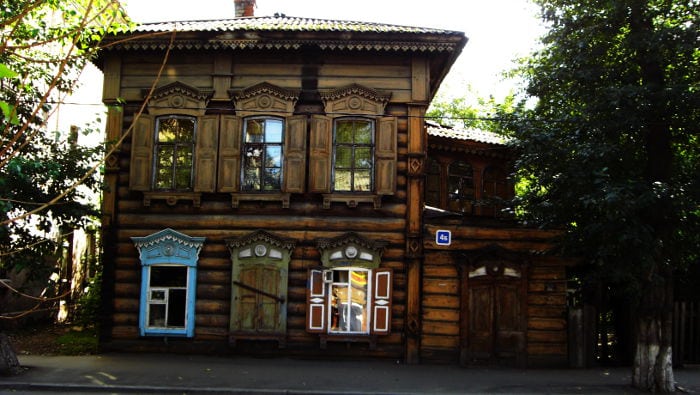 A house in Irkutz
A house in Irkutz
Where to stay? Our suggestions for hotels in Moscow, Irkutz, Ulan Bator and Beijing
Hotels in Moscow
Maxima Panorama: If you’re looking for a comfortable hotel to stay at in Moscow, this is a good option: it’s conveniently located to get anywhere in the city, offers excellent services, nice rooms and reasonable prices.
Souvenir Hostel: This hotel is also close to downtown and, even if it’s a bit more expensive than the next one, it does offer better facilities and it’s a perfect place for travelers.
Fabrika Hostel and Gallery: This hostel has an excellent location, is clean and offers good prices both for private and shared rooms. It’s probably the best option if you’re traveling on a budget.
Not enough? Click here to discover more hotels in Moscow (from 5 stars hotels to budget hotels).
Hotels in Irkutz
Angara Hotel: After the long train trip, you may want to stay in a nice place for a few days. In this case, you should check this hotel: the rooms are a bit small but they are clean and comfortable. Also, it’s located near the tourist attractions.
Dobriy Kot Bed & Breakfast: This bed & breakfast is probably one of the best choices in Irkutsk: excellent location, fair prices and helpful staff.
Hostel 490: A clean hostel, located near the tourist attractions, that offers cheap shared and private rooms.
Not enough? Click here to discover more hotels in Irkutz (from 5 stars hotels to budget hotels).
Hotels in Ulan Bator
Kaiser Hotel: Middle range hotel which is ideal if you want to have a good rest and a hot shower (not so easy to find in Ulan Bator). The hotel is located downtown and the rooms are big, clean and reasonably priced.
Golden Gobi: One of the few hostels in Ulan Bator. The Golden Gobi isn’t the most comfortable place but it’s probably the best place to get a tour. Keep in mind that you can book a tour even if you don’t spend the night there.
Not enough? Click here to discover more hotels in Ulan Bator (from 5 stars hotels to budget hotels).
Hotels in Beijing
Courtyard 7 Hotel: This wonderful hotel, located in a calm and central area, is designed in the style of old Beijing architecture. The rooms are big, clean and well decorated. The rooms aren’t cheap but are still a good deal if you take into account the facilities and the location.
Peking International Youth Hostel: This beautiful hostel is located in the heart of one of the most vibrant areas of Beijing. It offers clean and comfortable rooms and an impressive terrace. Its location, one of the most famous streets of Beijing, may represent a problem during the high season, as you’ll have to fight with thousands of Chinese tourists to reach your destination.
Leo Hostel: Every time I have gone to Beijing as a tourist, I have stayed in this hostel. It’s cheap, clean, has decent rooms, a beautiful courtyard and really friendly staff. Also, it’s located in a interesting hutong quite close to the Forbidden City (that is, in the heart of Beijing).
Not enough? Click here to discover more hotels in Beijing (from 5 stars hotels to budget hotels).
 Typical Gers in Mongolia, aren’t they cool?
Typical Gers in Mongolia, aren’t they cool?
Visa requirements
Yes, you need a Visa in order to enter Russia, China and Mongolia.
Generally speaking, you will have to apply for the Visas at the Russian, Mongolian and/or Chinese Consular Office in your country.
If for some reason you don’t want to, or you can’t show up personally to the Consular Office, you can use an agency to get your Chinese Visa. This will have a supplementary cost, but it may still be cheaper than the cost of the trip to the nearest CVASC or Chinese Consulate).
In this case you’ll have to send your passport (and other necessary documents) to the agency and they will handle everything. To apply for a visa service through an agency you can use the form above on the right.
At the moment we recommend VisaHQ, a trustworthy Visa agency. Click here to learn more!
Russian Visa
To get a Russian tourist Visa, you’ll need an invitation letter from a hotel or a travel agency. Most times you will have to pay for it (unless you go with a tour) So, plan well in advance.
Click here to know more about the Russian Visa.
Chinese Visa
Getting a Chinese tourist Visa can also be a difficult task as recently, they have been asking you to provide a round trip flight ticket reservation (that you won’t have because you’ll travel by train) and the hotel reservation for every day you stay in China. You can book a flight – and then cancel it – or ask the help of an agency. You can click here check out our suggestions about booking hotels in China
Click here to find out the details of the Chinese Visa application.
Mongolian Visa
From 1 January 2016 it is necessary to obtain a visa to go to Mongolia (unless you have a US or Canadian passport, or one of the other exempt countries).
To get a Mongolia visa you will need at least: Tickets (or reservations) of the trains or flights in and out of Mongolia (or tickets to and from China and/or Russia) and sometimes a travel insurance (click here for more information about travel insurances)
Click here to read everything you need to know to obtain a visa for Mongolia.
Things you should bring with you:
- Personal hygiene products: unless you chose to travel on first class trains, there will be no showers. Also, if you get off the train in Mongolia, don’t expect to find too many showers outside the capital.
- Warm clothes: Siberia is cold even during summer, especially during the night. Moreover, if you decide to go through Mongolia, warm clothes are a must because you’ll be in a vast plain at 1,500 meters average altitude where you may find snow even during summer. I really froze my ass off in Mongolia.
- A knife or a pocket knife: useful for the meals on the train.
- Cards or games: they are going to be your greatest allies on the train, also for socializing with locals. Chinese people love card games and Russians aren’t far behind them.
- An app or phrasebook in Russian, Chinese and even Mongolian: it will be essential for communicating with locals, as most don’t speak a word of English. However, the international language of signs never fails (except in China if you try with the numbers).
- If you carry an electronic device such a smart phone or a laptop, then also bring a multiple socket. The train cars normally have few outlets (one per compartment) so you’ll have to fight to charge your cell phone, camera or whatever.
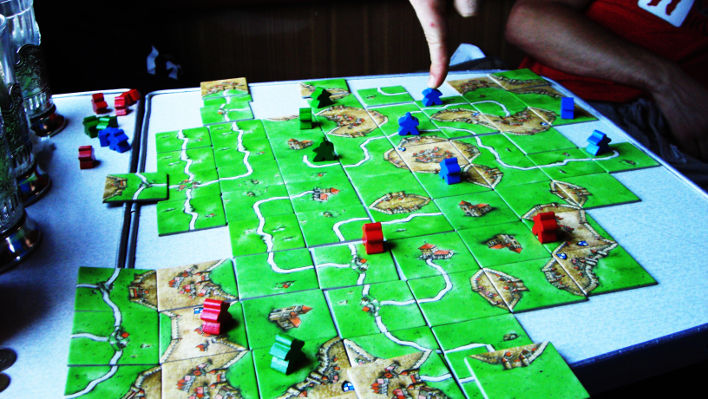 Playing Carcassonne on the train
Playing Carcassonne on the train
Essential information and tips
- Obtain your Visas well in advance, especially if you want to take the Trans-Mongolian route. Since you have to apply for one Visa at a time, it takes at least a month to get all of them.
- The timetables of the Russian trains are all set to Moscow’s time zone and it’s the same with the departure time printed on the tickets. So, be very careful with that, because the Trans-Siberian crosses eight time zones. In most stations, they have both Moscow time and local time. Mongolia also has different time zones, but the Trans-Mongolian line doesn’t cross any of them, so the time is ruled by Ulan Bator’s time zone. In China, you don’t have to worry because there is only one time zone.
- The railcars of the Russian, Mongolian and Chinese trains have a hot water dispenser. This will be essential for cooking the soups and instant noodles that are probably going to represent your main source of calories on the Trans-Siberian train.
- Russian railcars have a table with the schedule of all the stops during the journey and the duration of each of them. Usually, there are two long stops (20 minutes or more) per day. You can exploit them to get off the train and buy groceries and some fresh food (usually there will be a lot of sellers waiting on the platforms, as you can see on the photo below). This is also a good time to meet other foreigners on the train (I guarantee that you will recognize them quickly) and exchange impressions.
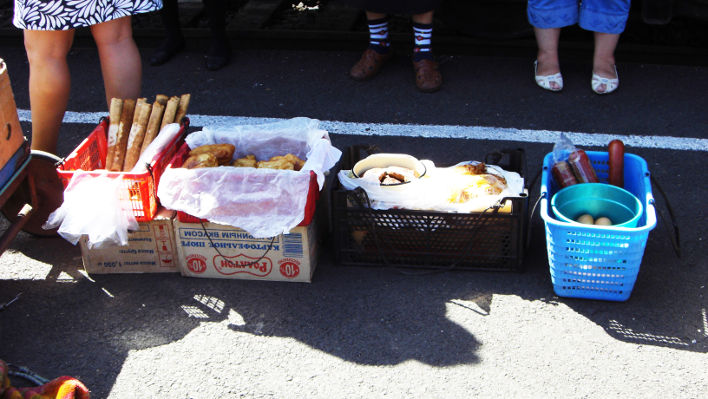 Some Siberian food to continue the trip ; )
Some Siberian food to continue the trip ; )
- Each Russian railcar has a person in charge called a provodnitsa (Проводница). They are usually women that don’t speak English and take care of everything concerning the railcar. Be nice to them and you’ll get everything you need.
- Along the Ulan Bator-Beijing route, there are only 2-3 trains per week (depending on the season). However, you always have the option of taking a train to the border, crossing it “walking” and then taking another train on the other side.
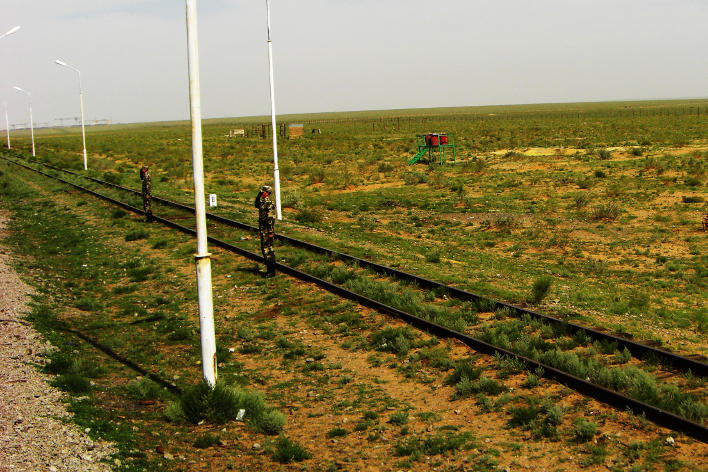 Say goodbye to the Mongolian soldiers before arriving in China ; )
Say goodbye to the Mongolian soldiers before arriving in China ; )
- If you still have some Mongolian Tugrik (the Mongolian currency), change them at the border. It won’t be difficult to find someone willing to take them at the Chinese border. Even if they cheat you with the change (they have to eat too!) this is your last chance to get rid of the Tugrik, as nobody else will accept them (I still have a lot of them at home).
By now, you should know everything you need to start this great journey. Don’t be shy about asking for advice or sharing your experience in the comments below : )
Photo Credits: ![]() our Vostok by annaspies
our Vostok by annaspies




Great guide, thanks for sharing!